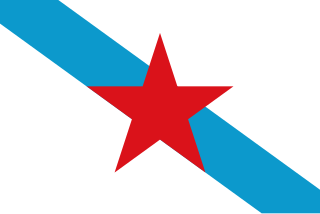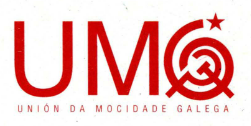
Galicianism is a regionalist political movement in Galicia.

Galicianism is a regionalist political movement in Galicia.
The concept of Galicianism first appeared in the mid-nineteenth century. At that time in history it was initially known as "provincialism". Soon it was referred to as regionalism. This was a reaction to the increased centralization of the Spanish State (following the French model of nation state) which attempted to eradicate internal administrative, and to some point cultural, differences within the country.
The term Galicianism as such was coined after the establishment of the Irmandades da Fala (Brotherhoods of the Galician Language), in 1916, and the apparition of modern Galician nationalism. The Irmandades da Fala was an organization hosting members from both the lower-middle-class and intellectuals. This organization was led by Antón Vilar Ponte. Within the next decade (1920s), this organization was strengthened by two groups: the nationalists, led by the Partido Galeguista (Galicianist Party) of Castelao, and the federalist republicans of ORGA. ORGA was directed by Santiago Casares and Antón Vilar.
In 1931, with the coming of the Spanish Second Republic, a number of drafts for a Statute of Autonomy were prepared by the Galicianists. The final version was approved in December 1932 at the Municipal Assembly of the Galician capital, Santiago de Compostela. The Statute of Autonomy was approved by referendum on 28 June 1936, and later ratified by the Spanish Parliament in 1937. However, the Spanish Civil War and the subsequent dictatorship put an end to the prospect of autonomy. At the end of the war (1939) many Galicianists were either executed or had to leave for exile.
The foundation of the Editorial Galaxia in 1950, publishing house promoting Galician culture and Galician language, was a visible act of resistance. Clandestine organizations supporting the cause of Marxism (as an opposition to the dictator) flourished in the 1950s and 1960s following the example of Editorial Galaxia and taking advantage of a timid relaxation of the dictatorial regime. Those new organizations and movements openly labelled themselves as nationalist, seeing themselves as the natural heirs of the early Galicianists (for example the Galician People's Union (UPG) was founded by some old Galicianists among other new members). All those organizations would claim Alfonso Daniel Rodríguez Castelao's classic work, Sempre en Galiza (1944), as the ideological cornerstone for Galician contemporary nationalism and even for their own foundational principles.
With the end of the dictatorship in 1975 and the passing of a new constitution in 1978, Galicianism was further strengthened up to the point that today the vast majority of political forces in Galicia call themselves Galicianist, whether they are nationalist or not, left wing or right wing.
For example, unlike in other Spanish autonomous communities, the conservative People's Party of Galicia includes Galicianism (seen as strong regionalism) as one of its ideological principles. [1] Even the Spanish Socialist Workers' Party has a strong regional flavour in Galicia, [2] [3] not to mention the actual main Galician nationalist party, the Galician Nationalist Bloc (BNG). A possible explanation for this is that Galician identity is so embedded in Galicians that any political party willing to participate in elections must at least show some degree of interest in the promotion of Galicianism, but it may range greatly, from moderate regionalism to outright claims for independence.

Alfonso Daniel Manuel Rodríguez Castelao, commonly known as Castelao, was a Galician politician, writer, painter and doctor. He is one of the fathers of Galician nationalism, promoting Galician identity and culture, and was one of the main names behind the cultural movement Xeración Nós. He was also one of the founders and president of the Galicianist Party and had a great influence on the renovating group of Galician art known as Os renovadores. Castelao is considered to be the most important figure in Galician culture of the 20th century.

A Nosa Terra was a Galician newspaper in Galician language, first founded in 1907 in A Coruña, Spain. It has been published in different periods.
Galician Workers' Party was a political party in Galicia, Spain.

Vicente Martínez Risco Agüero was a Galician intellectual of the 20th century. He was a founder member of Xeración Nós, and among the most important figures in the history of Galician literature. He is well regarded for his writings on Galician nationalism, as well as a contributor to the Galician New Narrative. He is also the father of Spanish novelist and critic Antonio Risco.

The Partido Galeguista was a Galician party founded in 1978, referring to itself as the historical descendant of the Partido Galeguista in the Second Spanish Republic (1931-1939).

The Galician People's Party was a Galician political party in the first years of the Spanish democracy.
The Irmandades da Fala was a Galician nationalist organization active between 1916 and 1936. It was the first political organization of Galicia that used only the Galician language.

Galician nationalism is a form of nationalism found mostly in Galicia, which asserts that Galicians are a nation and that promotes the cultural unity of Galicians. The political movement referred to as modern Galician nationalism was born at the beginning of the twentieth century from the idea of Galicianism.

Alexandre Bóveda Iglesias, commonly known as Alexandre Bóveda, was a Spanish politician and financial officer from Galicia. He is considered one of the most important Galicianist intellectuals during the Spanish Second Republic. He was one of the founders and key member of the Partido Galeguista, origin of contemporary Galician nationalism.

The Statute of Autonomy of Galicia of 1936 was a statute of autonomy for Galicia. It was voted in referendum and presented to the Spanish Parliament. Yet, it could never be implemented because of the Spanish Civil War (1936–1939) and subsequent Francoist Spain (1939–1977). The 1936 statute was drafted by the Partido Galeguista, and it is the historical precedent of the current Statute of Autonomy of Galicia of 1981.
The Partido Galeguista was a Galician nationalist party founded in December 1931. It achieved notoriety during the time of the Spanish Second Republic. The PG grouped a number of historical Galician intellectuals, and was fundamental in the elaboration of the Galician Statute of Autonomy.
The Autonomous Galician Republican Organization was a Spanish left-wing republican and Galician nationalist party in Galicia. It was founded in October 1929 in A Coruña by Santiago Casares Quiroga and Antón Vilar Ponte with the participation of the Irmandades da Fala.
Dereita Galeguista was a right-wing Galician nationalist party active in the final months of the Second Spanish Republic.
The Galician Social Democratic Party was a Galician political party with a Galician nationalist and social democratic ideology.
The Galician Nationalist Party–Galicianist Party is a Galician nationalist and liberal political party, coming from a split of the Galician Coalition. The PNG–PG had 132 members in 2002. Xosé Mosquera Casero is its secretary general, after the VIII Congress in September 2011.
The Nationalist Galicianist Party (PGN or PG(N), Partido Galeguista Nacionalista or Partido Galeguista (Nacionalista) in Galician language) was a Galician nationalist party founded in 1984.
The Federación de Mocedades Galeguistas was the youth organization of the Partido Galeguista, which was formed in January 1934, bringing together the different local nationalist youth organizations that had been formed since 1932. It had around 1,000 members, its official organ was the Guieiro, and their leaders were Xaime Illa Couto, Celso Emilio Ferreiro, Xosé Velo and Ramón Piñeiro López.

The Galician Youth Union is the youth wing of the Galician People's Union. It was created in August 1977.

Galician Coalition is a political party in Galicia, Spain with a Galician nationalist and centrist ideology. Since 2012 CG is part of the coalition Compromiso por Galicia.
The Republican Nationalist Party of Ourense was a Galician nationalist party founded in late 1930 based in the province of Ourense. The main leaders of the party were Ramón Otero Pedrayo, Xaquín Lorenzo Fernández, Florentino López Cuevillas and Vicente Risco.